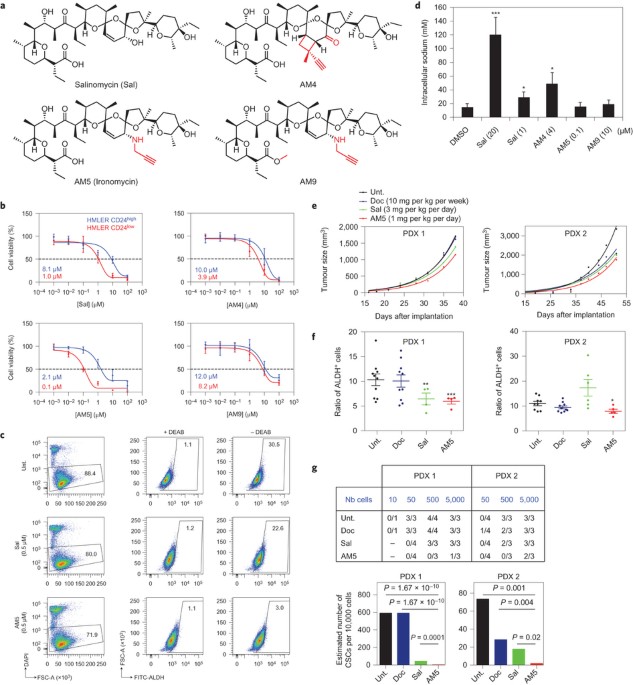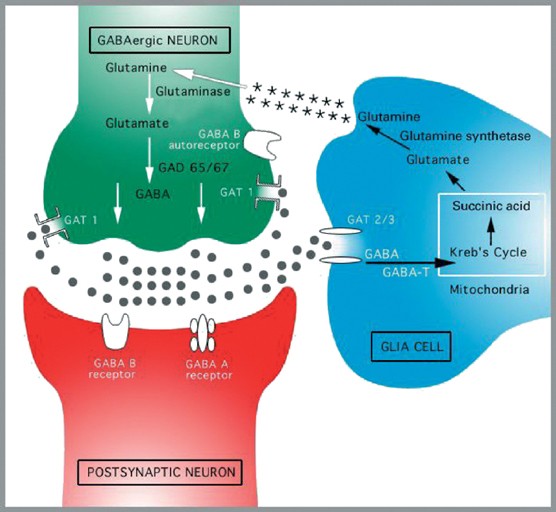
- Select a language for the TTS:
- UK English Female
- UK English Male
- US English Female
- US English Male
- Australian Female
- Australian Male
- Language selected: (auto detect) - EN
Play all audios:
ABSTRACT Cancer stem cells (CSCs) represent a subset of cells within tumours that exhibit self-renewal properties and the capacity to seed tumours. CSCs are typically refractory to
conventional treatments and have been associated to metastasis and relapse. Salinomycin operates as a selective agent against CSCs through mechanisms that remain elusive. Here, we provide
evidence that a synthetic derivative of salinomycin, which we named ironomycin (AM5), exhibits a more potent and selective activity against breast CSCs _in vitro_ and _in vivo_, by
accumulating and sequestering iron in lysosomes. In response to the ensuing cytoplasmic depletion of iron, cells triggered the degradation of ferritin in lysosomes, leading to further iron
loading in this organelle. Iron-mediated production of reactive oxygen species promoted lysosomal membrane permeabilization, activating a cell death pathway consistent with ferroptosis.
These findings reveal the prevalence of iron homeostasis in breast CSCs, pointing towards iron and iron-mediated processes as potential targets against these cells. Access through your
institution Buy or subscribe This is a preview of subscription content, access via your institution ACCESS OPTIONS Access through your institution Access Nature and 54 other Nature Portfolio
journals Get Nature+, our best-value online-access subscription $29.99 / 30 days cancel any time Learn more Subscribe to this journal Receive 12 print issues and online access $259.00 per
year only $21.58 per issue Learn more Buy this article * Purchase on SpringerLink * Instant access to full article PDF Buy now Prices may be subject to local taxes which are calculated
during checkout ADDITIONAL ACCESS OPTIONS: * Log in * Learn about institutional subscriptions * Read our FAQs * Contact customer support SIMILAR CONTENT BEING VIEWED BY OTHERS INHIBITION OF
LYSOSOMAL TRPML1 CHANNEL ELIMINATES BREAST CANCER STEM CELLS BY TRIGGERING FERROPTOSIS Article Open access 27 May 2024 MTOR INHIBITION SUPPRESSES SALINOMYCIN-INDUCED FERROPTOSIS IN BREAST
CANCER STEM CELLS BY IRONING OUT MITOCHONDRIAL DYSFUNCTIONS Article Open access 15 November 2023 MUC1-C IS A TARGET OF SALINOMYCIN IN INDUCING FERROPTOSIS OF CANCER STEM CELLS Article Open
access 05 January 2024 REFERENCES * Nieto, M. N., Huang, R. Y.-J., Jackson, R. A. & Thiery, J. P. EMT: 2016. _Cell_ 166, 21–45 (2016). CAS PubMed Google Scholar * Tam, W. L. &
Weinberg, R. A. The epigenetics of epithelial-mesenchymal plasticity in cancer. _Nat. Med._ 19, 1438–1449 (2013). CAS PubMed PubMed Central Google Scholar * Pattabiraman, D. R. &
Weinberg, R. A. Tackling the cancer stem cells–what challenges do they pose? _Nature Rev. Drug Discov._ 13, 497–512 (2014). CAS Google Scholar * Kelly, P. N., Dakic, A., Adams, J. M.,
Nutt, S. L. & Strasser, A. Tumor growth need not be driven by rare cancer stem cells. _Science_ 317, 337 (2007). CAS PubMed Google Scholar * Quintana, E. et al. Efficient tumour
formation by single melanoma cells. _Nature_ 456, 593–598 (2008). CAS PubMed PubMed Central Google Scholar * Gupta, P. B. et al. Identification of selective inhibitors of cancer stem
cells by high-throughput screening. _Cell_ 138, 645–659 (2009). CAS PubMed PubMed Central Google Scholar * Morel, A.-P. et al. Generation of breast cancer stem cells through
epithelial–mesenchymal transition. _PLoS ONE_ 3, e2888 (2008). PubMed PubMed Central Google Scholar * Germain, A. R. et al. Identification of a selective small molecule inhibitor of
breast cancer stem cells. _Bioorg. Med. Chem. Lett._ 22, 3571–3574 (2012). CAS PubMed Google Scholar * Hartwell, K. A. et al. Niche-based screening identifies small-molecule inhibitors of
leukemia stem cells. _Nat. Chem. Biol._ 9, 840–848 (2013). CAS PubMed PubMed Central Google Scholar * Paulus, E. F., Kurz, M., Matter, H. & Vértesy, L. Solid-state and solution
structure of the salinomycin-sodium complex: stabilization of different conformers for an ionophore in different environments. _J. Am. Chem. Soc._ 120, 8209–8221 (1998). CAS Google Scholar
* Lu, D. et al. Salinomycin inhibits Wnt signaling and selectively induces apoptosis in chronic lymphocytic leukemia cells. _Proc. Natl Acad. Sci. USA_ 108, 13253–13257 (2011). CAS PubMed
Google Scholar * Yue, W. et al. Inhibition of the autophagic flux by salinomycin in breast cancer stem-like/progenitor cells interferes with their maintenance. _Autophagy_ 9, 714–729
(2013). CAS PubMed PubMed Central Google Scholar * Naujokat, C. & Steinhart, R. Salinomycin as a drug for targeting human cancer stem cells. _J. Biomed. Biotechnol._ 2012, 950658
(2012). PubMed PubMed Central Google Scholar * Huczyński, A. et al. Antiproliferative activity of salinomycin and its derivatives. _Bioorg. Med. Chem. Lett._ 22, 7146–7150 (2012). PubMed
Google Scholar * Borgström, B. et al. Synthetic modification of salinomycin: selective _O_-acylation and biological evaluation. _Chem. Commun._ 49, 9944–9946 (2013). Google Scholar *
Huang, X. et al. Semisynthesis of SY-1 for investigation of breast cancer stem cell selectivity of C-ring-modified salinomycin analogues. _ACS Chem. Biol._ 9, 1587–1594 (2014). CAS PubMed
Google Scholar * Borgström, B., Huang, X., Chygorin, E., Oredsson, S. & Strand, D. Salinomycin hydroxamic acids: synthesis, structure, and biological activity of polyether ionophore
hybrids. _ACS Chem. Med. Lett._ 7, 635–640 (2016). Google Scholar * Shi, Q. et al. Discovery of a 19F MRI sensitive salinomycin derivative with high cytotoxicity towards cancer cells.
_Chem. Commun._ 52, 5136–5139 (2016). CAS Google Scholar * Borgström, B., Huang, X., Hegardt, C., Oredsson, S . & Strand, D. Structure-activity relationships in salinomycin:
cytotoxicity and phenotype selectivity of semi-synthetic derivatives. _Chem. Eur. J._ 23, 2077–2083 (2017). PubMed Google Scholar * Nishi, M. et al. Induction of cells with cancer stem
cell properties from nontumorigenic human mammary epithelial cells by defined reprogramming factors. _Oncogene_ 33, 643–652 (2014). CAS PubMed Google Scholar * Minta, A. & Tsien, R.
Y. Fluorescent indicators for cytosolic sodium. _J. Biol. Chem._ 264, 19449–19457 (1989). CAS PubMed Google Scholar * Charafe-Jauffret, E. et al. ALDH1-positive cancer stem cells predict
engraftment of primary breast tumors and are governed by a common stem cell program. _Cancer Res._ 73, 7290–7300 (2013). CAS PubMed Google Scholar * Rodriguez, R. et al.
Small-molecule-induced DNA damage identifies alternative DNA structures in human genes. _Nat. Chem. Biol._ 8, 301–310 (2012). CAS PubMed PubMed Central Google Scholar * Larrieu, D.,
Britton, S., Demir, M., Rodriguez, R. & Jackson, S. P. Chemical inhibition of NAT10 corrects defects of laminopathic cells. _Science_ 344, 527–532 (2014). CAS PubMed PubMed Central
Google Scholar * Abell, N. S., Mercado, M., Cañeque, T., Rodriguez, R. & Xhemalce, B. Click quantitative mass spectrometry identifies PIWIL3 as a mechanistic target of RNA interference
activator enoxacin in cancer cells. _J. Am. Chem. Soc._ 139, 1400–1403 (2017). CAS PubMed Google Scholar * Cañeque, T. et al. Synthesis of marmycin A and investigation into its cellular
activity. _Nat. Chem._ 7, 744–751 (2015). PubMed PubMed Central Google Scholar * Pantopoulos, K., Porwal, S. K., Tartakoff, A. & Devireddy, L. Mechanisms of mammalian iron
homeostasis. _Biochemistry_ 51, 5705–5724 (2012). CAS PubMed PubMed Central Google Scholar * Asano, T. et al. Distinct mechanisms of ferritin delivery to lysosomes in iron-depleted and
iron-replete cells. _Mol. Cell Biol._ 10, 2040–2052 (2011). Google Scholar * Hirayama, T., Okuda, K. & Nagasawa, H. A highly selective turn-on fluorescent probe for iron(II) to
visualize labile iron in living cells. _Chem. Sci._ 4, 1250–1256 (2013). CAS Google Scholar * Li, T. et al. Salinomycin induces cell death with autophagy through activation of endoplasmic
reticulum stress in human cancer cells. _Autophagy_ 9, 1057–1068 (2013). CAS PubMed PubMed Central Google Scholar * Dixon, S. J. & Stockwell, B. R. The role of iron and reactive
oxygen species in cell death. _Nat. Chem. Biol._ 10, 9–17 (2014). CAS PubMed Google Scholar * Boya, P. & Kroemer, G. Lysosomal membrane permeabilization in cell death. _Oncogene_ 27,
6434–6451 (2008). CAS PubMed Google Scholar * Aits, S. & Jäättelä, M. Lysosomal cell death at a glance. _J. Cell Sci._ 126, 1905–1912 (2013). CAS PubMed Google Scholar * Galluzzi,
L., Bravo-San Pedro, J. M. & Kroemer, G. Organelle-specific initiation of cell death. _Nat. Cell. Biol._ 16, 728–736 (2014). CAS PubMed Google Scholar * Dixon, S. J. et al.
Ferroptosis: an iron-dependent form of nonapoptotic cell death. _Cell_ 149, 1060–1072 (2012). CAS PubMed PubMed Central Google Scholar * Yang, W. S. et al. Regulation of ferroptotic
cancer cell death by GPX4. _Cell_ 156, 317–331 (2014). CAS PubMed PubMed Central Google Scholar * Conrad, M., Angeli, J. P. F., Vandenabeele, P. & Stockwell, B. R. Regulated
necrosis: disease relevance and therapeutic opportunities. _Nat. Rev. Drug. Discov._ 15, 348–366 (2016). CAS PubMed PubMed Central Google Scholar * Yang, W. S. & Stockwell, B. R.
Ferroptosis: death by lipid peroxidation. _Trends Cell Biol._ 26, 165–176 (2016). CAS PubMed Google Scholar * Cao, J. Y. & Dixon, S. J. Mechanisms of ferroptosis. _Cell. Mol. Life
Sci._ 73, 2195–2209 (2016). CAS PubMed PubMed Central Google Scholar * Torti, S. V. & Torti, F. M. Iron and cancer: more ore to be mined. _Nat. Rev. Cancer_ 13, 342–355 (2013). CAS
PubMed PubMed Central Google Scholar * Takebe, N. et al. Targeting Notch, Hedgehog, and Wnt pathways in cancer stem cells: clinical update. _Nature Rev. Clin. Oncol._ 12, 445–464 (2015).
CAS Google Scholar * West, N. R., Murray, J. I. & Watson, P. H. Oncostatin-M promotes phenotypic changes associated with mesenchymal and stem cell-like differentiation in breast
cancer. _Oncogene_ 33, 1485–1494 (2014). CAS PubMed Google Scholar * Schonberg, D. L. et al. Preferential iron trafficking characterizes glioblastoma stem-like cells. _Cancer Cell_ 28,
441–455 (2015). CAS PubMed PubMed Central Google Scholar * Pinnix, Z. K. et al. Ferroportin and iron regulation in breast cancer progression and prognosis. _Sci. Transl. Med._ 2, 43ra56
(2010). PubMed PubMed Central Google Scholar * Yamane, K. et al. PLU-1 is an H3K4 demethylase involved in transcriptional repression and breast cancer cell proliferation. _Mol. Cell_ 25,
801–812 (2007). CAS PubMed Google Scholar * Yamamoto, S. et al. JARID1B is a luminal lineage-driving oncogene in breast cancer. _Cancer Cell_ 25, 762–777 (2014). CAS PubMed PubMed
Central Google Scholar * Greer, E. L. & Shi, Y. Histone methylation: a dynamic mark in health, disease and inheritance. _Nat. Rev. Genet._ 13, 343–357 (2012). CAS PubMed PubMed
Central Google Scholar * Shen, L. et al. Genome-wide analysis reveals TET- and TDG-dependent 5-methylcytosine oxidation dynamics. _Cell_ 153, 692–706 (2013). CAS PubMed PubMed Central
Google Scholar * Tsai, Y.-P. et al. TET1 regulates hypoxia-induced epithelial-mesenchymal transition by acting as a co-activator. _Genome Biol._ 15, 513 (2014). PubMed PubMed Central
Google Scholar * Hu, X. et al. Tet and TDG mediate DNA demethylation essential for mesenchymal-to-epithelial transition in somatic cell reprogramming. _Cell Stem Cell_ 14, 512–522 (2014).
CAS PubMed Google Scholar Download references ACKNOWLEDGEMENTS We thank the CNRS, INSERM and SATT IDF Innov for generous funding. Research in the R.R. laboratory is supported by the
European Research Council (grant number 647973), Fondation pour la Recherche Médicale (grant reference AJE20141031486), Emergence Ville de Paris and Ligue Contre le Cancer. A.Ha. is funded
by the Fondation de France. We acknowledge the PICT-IBiSA@Pasteur Imaging Facility of Institut Curie, member of the France-BioImaging national research infrastructure. We thank P. Le Bacon
for assistance with high-resolution microscopy, J.-F. Gallard, N. Birlirakis and C. Gaillet for assistance with NMR spectroscopy and J. Poupon for electrothermal atomic absorption
spectrometry experiments. We thank A. Puisieux for providing us with HMLER cells and V. Mitz for mammary tissues obtained from reduction mammoplasty. AUTHOR INFORMATION Author notes * Trang
Thi Mai, Ahmed Hamaï and Antje Hienzsch: These authors contributed equally to this work. AUTHORS AND AFFILIATIONS * Institut Curie, PSL Research University, Chemical Cell Biology Group, 26
rue d'Ulm, Paris Cedex 05, 75248, France Trang Thi Mai, Tatiana Cañeque, Sebastian Müller, Verónica Acevedo & Raphaël Rodriguez * CNRS UMR3666, Paris, 75005, France Trang Thi Mai,
Tatiana Cañeque, Sebastian Müller, Verónica Acevedo & Raphaël Rodriguez * INSERM U1143, Paris, 75005, France Trang Thi Mai, Tatiana Cañeque, Sebastian Müller, Verónica Acevedo &
Raphaël Rodriguez * Institut de Chimie des Substances Naturelles, UPR2301, 1 Avenue de la Terrasse, Gif-sur-Yvette Cedex, 91198, France Trang Thi Mai, Antje Hienzsch, Tatiana Cañeque &
Raphaël Rodriguez * Institut Necker-Enfants Malades, INSERM U1151-CNRS UMR8253, Université Paris Descartes-Sorbonne Paris Cité, 14 rue Maria Helena Vieira Da Silva, Paris Cedex 14, 75993,
France Ahmed Hamaï, Christine Leroy, Amandine David, Patrice Codogno & Maryam Mehrpour * ABX advanced biochemical compounds, Heinrich-Glaeser-Str. 10-14, Radeberg, D-01454, Germany Antje
Hienzsch * Aix Marseille Université, CNRS, INSERM, Institut Paoli-Calmettes, CRCM, Equipe Oncologie Moléculaire labellisée ‘Ligue contre le cancer’, Marseille, 13009, France Julien
Wicinski, Olivier Cabaud, Christophe Ginestier, Daniel Birnbaum & Emmanuelle Charafe-Jauffret * Department of Microbiology, Yokohama City University School of Medicine, Yokohama,
236-0004, Japan Akihide Ryo Authors * Trang Thi Mai View author publications You can also search for this author inPubMed Google Scholar * Ahmed Hamaï View author publications You can also
search for this author inPubMed Google Scholar * Antje Hienzsch View author publications You can also search for this author inPubMed Google Scholar * Tatiana Cañeque View author
publications You can also search for this author inPubMed Google Scholar * Sebastian Müller View author publications You can also search for this author inPubMed Google Scholar * Julien
Wicinski View author publications You can also search for this author inPubMed Google Scholar * Olivier Cabaud View author publications You can also search for this author inPubMed Google
Scholar * Christine Leroy View author publications You can also search for this author inPubMed Google Scholar * Amandine David View author publications You can also search for this author
inPubMed Google Scholar * Verónica Acevedo View author publications You can also search for this author inPubMed Google Scholar * Akihide Ryo View author publications You can also search for
this author inPubMed Google Scholar * Christophe Ginestier View author publications You can also search for this author inPubMed Google Scholar * Daniel Birnbaum View author publications
You can also search for this author inPubMed Google Scholar * Emmanuelle Charafe-Jauffret View author publications You can also search for this author inPubMed Google Scholar * Patrice
Codogno View author publications You can also search for this author inPubMed Google Scholar * Maryam Mehrpour View author publications You can also search for this author inPubMed Google
Scholar * Raphaël Rodriguez View author publications You can also search for this author inPubMed Google Scholar CONTRIBUTIONS R.R. conceptualized the study and designed ironomycin. R.R.,
T.T.M., M.M., A.Ha. and P.C. designed the experiments and analysed the data. T.T.M., A.Hi., A.Ha. and M.M. performed the experiments unless stated otherwise. A.Hi. and T.C. synthesized Sal
derivatives and performed NMR experiments. J.W., O.C., C.G., D.B. and E.C.-J. provided PDX data. A.Ha., C.L. and A.D. provided MCF-7 tumour data. S.M. and V.A. provided assistance with cell
imaging. A.R. provided iCSCL-10A2 cells. R.R. wrote the manuscript with contributions from T.C., S.M., A.Hi., A.Ha. and M.M. CORRESPONDING AUTHORS Correspondence to Maryam Mehrpour or
Raphaël Rodriguez. ETHICS DECLARATIONS COMPETING INTERESTS The authors declare no competing financial interests. SUPPLEMENTARY INFORMATION SUPPLEMENTARY INFORMATION Supplementary information
(PDF 34921 kb) RIGHTS AND PERMISSIONS Reprints and permissions ABOUT THIS ARTICLE CITE THIS ARTICLE Mai, T., Hamaï, A., Hienzsch, A. _et al._ Salinomycin kills cancer stem cells by
sequestering iron in lysosomes. _Nature Chem_ 9, 1025–1033 (2017). https://doi.org/10.1038/nchem.2778 Download citation * Received: 21 April 2016 * Accepted: 03 April 2017 * Published: 16
May 2017 * Issue Date: October 2017 * DOI: https://doi.org/10.1038/nchem.2778 SHARE THIS ARTICLE Anyone you share the following link with will be able to read this content: Get shareable
link Sorry, a shareable link is not currently available for this article. Copy to clipboard Provided by the Springer Nature SharedIt content-sharing initiative








